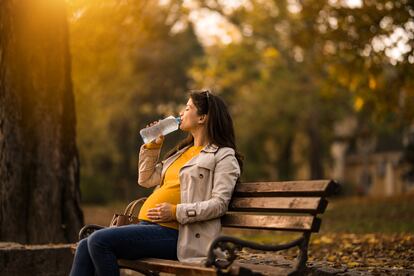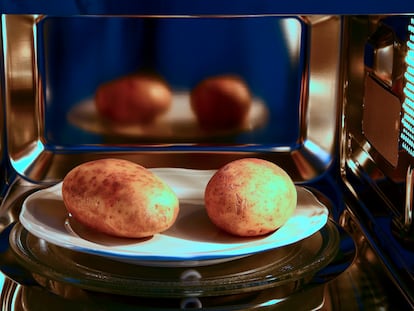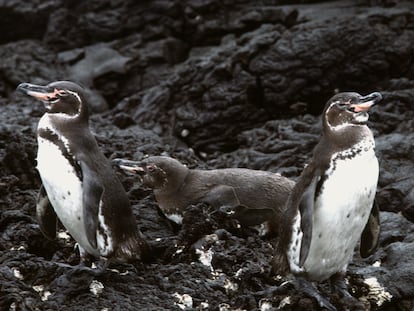The health impacts of nanoplastics found in breast milk and cells
Studies of cells and animals indicate that these particles may cause harm, but there is no clear evidence yet of human risk

In 2022, a team led by Marja H. Lamoree from the Free University of Amsterdam published a study with some concerning findings. They used a new technique to analyze blood samples from 22 people and discovered that 77% had plastic particles. Lamoree’s team theorized that if these particles are transported by immune cells, they could affect the body’s defenses and immune disease susceptibility. In 2021, a team led by Antonio Ragusa of the Fatebenefratelli Hospital in Rome, first detected microplastics in pregnant women’s placentas. However, they couldn’t determine whether the particles were also in the babies’ bodies. In another study a year later, the same team identified plastic particles in the breast milk of three out of four mothers.
“Until very recently, we thought that when microplastics entered our bodies, they were later expelled through digestion. We believed a particle could trigger inflammation in the digestive tract as it passed, but not that they could cross cellular barriers and accumulate in organs. Now we know that this does happen,” said Ana Isabel Cañas, director of Madrid’s National Center for Environmental Health. Plastic has been ubiquitous for decades, with growing worry about the long-lasting waste in our oceans and landfills. New microscopy techniques reveal how minuscule plastic particles, some smaller than bacteria, now infiltrate and remain in organisms.
New detection methods have revealed a spate of worrisome findings. A recent study published in the PNAS journal by Columbia University researchers found approximately 250,000 tiny plastic pieces in a one-liter plastic bottle. These materials break down into even smaller pieces that can be unknowingly inhaled or ingested.
“Considering that our lungs filter about 12,000 liters of air a day, we are continuously exposed to different MNPs [micro and nano particles], and their associated additives, other pollutants and microorganisms, making the inhalation route of especial concern,” said a study conducted by researchers from three Spanish institutions. This is likely the main route in our bodies for nanoplastics released by clothing or rubber from car tires. These plastics can be particularly harmful as they weren’t designed for food safety, like plastic beverage containers.
José Domínguez of the Germans Trias i Pujol Research Institute in Badalona (Spain) was a co-author of the study. The team he led found evidence in cellular and animal models showing nanoplastics accumulate and affect the inflammatory response, potentially causing long-term health problems. Acknowledging there is no conclusive evidence that the same happens in humans, Domínguez and his team are studying these substances’ impact on interactions with microbes linked to respiratory diseases. “Plastics can actually bring in tiny microorganisms into our bodies. But sometimes the plastic pieces are so small that the microorganisms carry them,” said Domínguez. Plastic can lead to inflammation and weaken the immune response, potentially allowing bacteria like staphylococcus aureus to cause even more severe infections. When considering the impact of these pervasive lifestyle products on health, we also need to account for the effects of other contaminants like traffic pollution.
Plastics meant for food contact are non-toxic, but exposure to sunlight or aging can alter their properties. When this happens, no one is certain about their behavior, especially when microplastics interact with the environment. “They might be toxic, because the manufacturing quality controls are no longer relevant,” said Jorge Bernardino de la Serna, from Imperial College London. He said it was assumed that safe microplastics were consumed and expelled after digestion. “When we saw pieces of plastic in blood bags, we all started to worry.”
Nanoparticles that transport toxins
Dr. Bernardino de la Serna says that pure plastics are well-made and relatively harmless, so cells absorb them like regular food. Since plastics are non-biodegradable, the particles get incorporated into the cell and spread to new cells during division, just like other components. “This is concerning because they can enter the bloodstream, reach other organs or lymph nodes, impact the immune system, and even breach the protective blood-brain barrier,” he said. Some scientists view this mechanism as a potential cause for certain mental or neurological diseases, possibly linked to toxic elements or endocrine disruptors carried by nanoparticles. Studies in mice show that microplastics may lower sperm quality, which could explain some of the observed decline in humans over the past 50 years.
“We don’t have the analytical tools to quantify and identify every type of plastic due to the vast variety and differing toxicity levels,” said Cañas. She cautions about pinpointing the harm caused by a single substance when it is typically found in combination with others in the real world. “Addressing the risks of a basic compound like bisphenol A is simpler than dealing with a particle that includes various additives for flexibility, color change and water resistance. It’s difficult to attribute toxicity to any one substance,” she said. To make progress in this new line of research, we need methods to analyze the real-world effects of plastics, not just the pure plastics typically studied.
Scientists say the health impact of micro and nanoplastics remains unknown. Techniques are being developed to assess these particles accurately. The EU launched the CUSP cluster in 2021, with five research consortia: AURORA, IMPTOX, Plastic Heal, PlasticsFatE, and POLYRISK, to study their effects. As results emerge, simple suggestions like switching from plastic bottles to glass are helpful, but replacing plastics is a complex challenge. In 1950, global plastic production was two million tons. By 2021, it reached 461 million tons and is projected to hit 590 million by 2050, with only 9% recycled. Even with decreased production, particles from all the existing plastic will endure in the environment, dispersing through our air and water for centuries to come.
Sign up for our weekly newsletter to get more English-language news coverage from EL PAÍS USA Edition
Tu suscripción se está usando en otro dispositivo
¿Quieres añadir otro usuario a tu suscripción?
Si continúas leyendo en este dispositivo, no se podrá leer en el otro.
FlechaTu suscripción se está usando en otro dispositivo y solo puedes acceder a EL PAÍS desde un dispositivo a la vez.
Si quieres compartir tu cuenta, cambia tu suscripción a la modalidad Premium, así podrás añadir otro usuario. Cada uno accederá con su propia cuenta de email, lo que os permitirá personalizar vuestra experiencia en EL PAÍS.
¿Tienes una suscripción de empresa? Accede aquí para contratar más cuentas.
En el caso de no saber quién está usando tu cuenta, te recomendamos cambiar tu contraseña aquí.
Si decides continuar compartiendo tu cuenta, este mensaje se mostrará en tu dispositivo y en el de la otra persona que está usando tu cuenta de forma indefinida, afectando a tu experiencia de lectura. Puedes consultar aquí los términos y condiciones de la suscripción digital.
More information
Últimas noticias
Most viewed
- Sinaloa Cartel war is taking its toll on Los Chapitos
- Oona Chaplin: ‘I told James Cameron that I was living in a treehouse and starting a permaculture project with a friend’
- Reinhard Genzel, Nobel laureate in physics: ‘One-minute videos will never give you the truth’
- Why the price of coffee has skyrocketed: from Brazilian plantations to specialty coffee houses
- Silver prices are going crazy: This is what’s fueling the rally











































